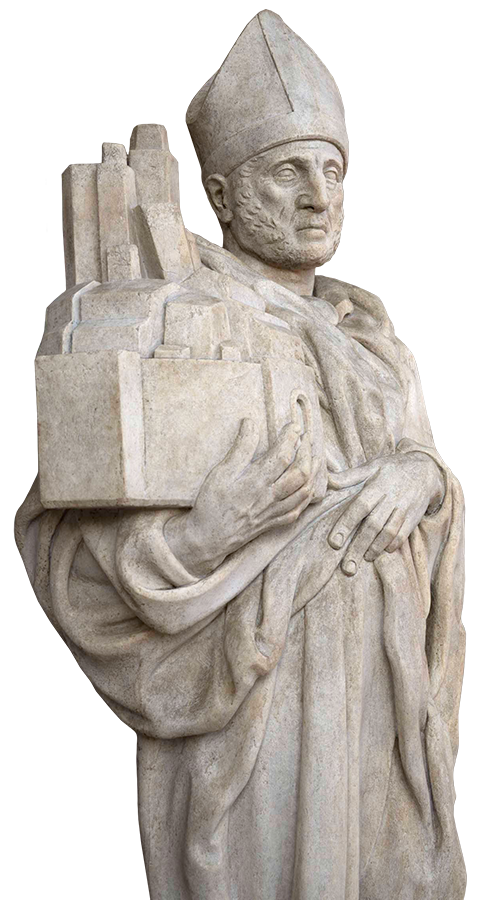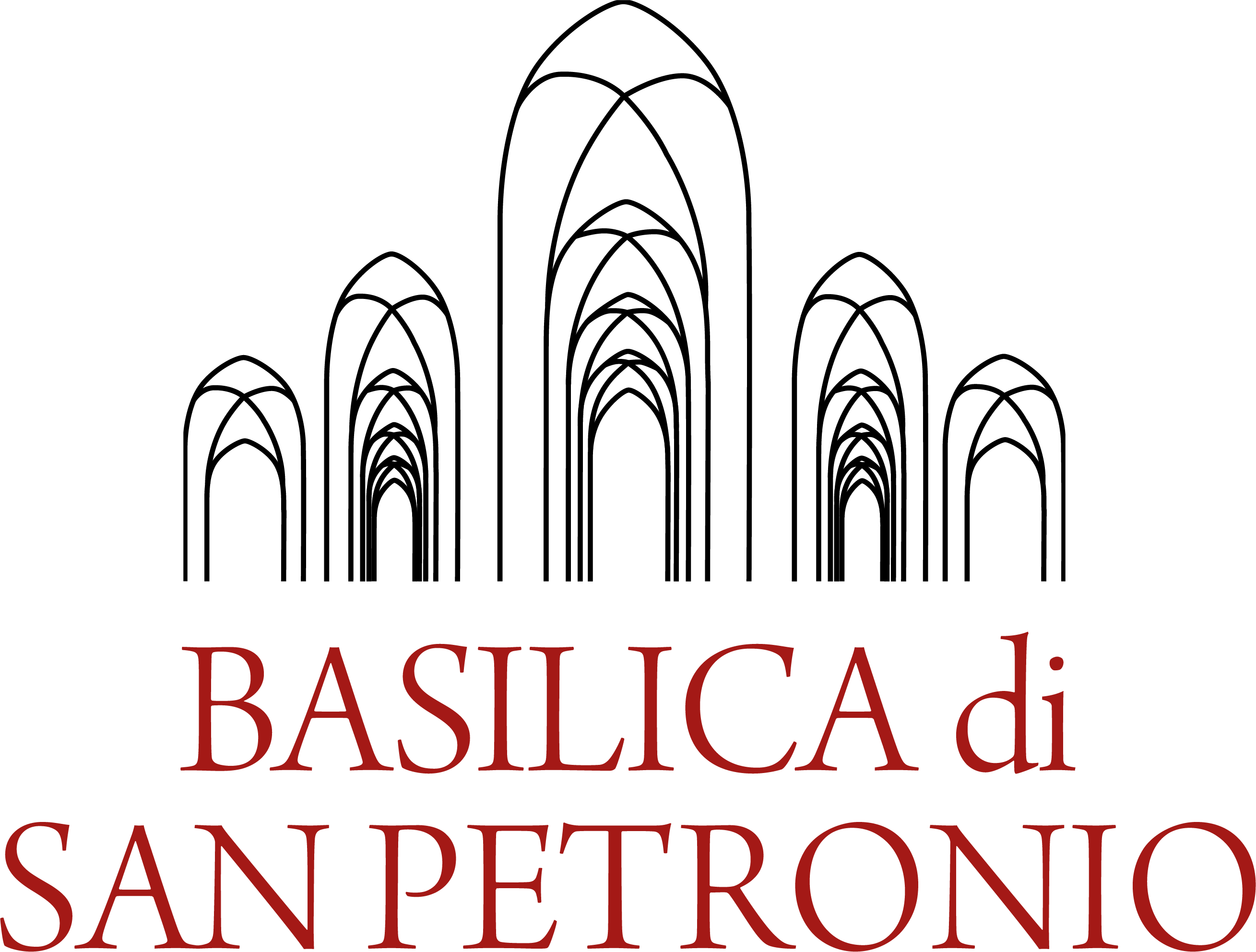

Built between 1390 and 1663, the Basilica of San Petronio is one of the most majestic and important examples of an Italian Gothic cathedral.
Despite its large size (132 metres long, 60 metres wide and 44 metres high), the Basilica has a harmonious and balanced appearance that softens the sometimes exaggerated verticalism of the Gothic style, interpreting it in an entirely original way.

Built between 1390 and 1663, the Basilica di San Petronio is one of the most majestic and significant examples of an Italian Gothic cathedral. Despite its large size (132 metres long, 60 metres wide and 44 metres high), the Basilica has a harmonious and balanced appearance that softens the sometimes exaggerated verticalism of the Gothic style, interpreting it in a totally original way.
formerly Santa Maria de’ Rustigani
Chapel of Madonna della Pace
This chapel was once dedicated to Santa Maria de’ Rustigani. It houses a sculpture of Our Lady of Peace (1394) carved in Istrian stone by the German sculptor Giovanni Ferabech.
formerly Pepoli
Chapel of Santa Brigida
The main work in this space is the Precious Polyptych (1477) painted on wood by Tommaso Garelli. The votive paintings on the side walls of the chapel are also very interesting.
formely Marsili
Chapel of Sant’Ambrogio
The fresco polyptych above the altar (c. 1474) is attributed to Jacopo di Cristoforo Moretti. It depicts Saint Ambrose in the centre and two military saints (possibly Proculus and Florian) at his sides.
formerly of the Società dei Notai, today Rinaldi
Chapel of Santa Croce
On the altar is a crucifix painted on a moulded panel, made by Ercole Banci in the early 16th century.The stained glass window in the chapel was made between 1464 and 1466 by the Dominican friar Jacob Griesinger (Giacomo da Ulma).
formerly Garganelli, then Ratta, then of the Fabbrica
Chapel of San Lorenzo
The chapel was renovated in 1908: the large window was reopened and a bust of St Laurence by Giuseppe Romagnoli, along with a painting of the Pietà (1519) by Amico Aspertini, were placed above the altar.
formerly Castelli
Chapel of San Girolamo
The altar features a gilded wooden altarpiece from the first half of the 16th century. The panel, depicting Saint Jerome in his chair (1484) surrounded by almost metaphysical architecture, is a work by Lorenzo Costa.
formerly Fantuzzi, then of the Fabbrica
Chapel of Immacolata
The decoration of the Chapel of Immacolata is completely modern (1908-1951). The design was conceived by the painter Achille Casanova based on the oldest statue of the Immaculate Madonna (1725).
formerly Ramazzotti, then Malvezzi Campeggi
Chapel of Santissimo Sacramento
The inlaid stalls set against the side walls, executed between 1513 and 1521 by the monk Raffaele da Brescia, are particularly noteworthy.
formerly Saraceni, then Cospi
Chapel of St. Anthony of Padua
The chapel preserves, unified and intact, the decorative apparatus executed between 1524 and 1526 by the painter and sculptor Girolamo da Treviso. The artist executed both the statue of St. Anthony above the altar and the cycle of oil paintings on the wall depicting the Saint’s miracles.
There is also an exquisite monumental stained-glass window executed in two different periods. Initially, around 1518, the rose window with Saint Anthony, the two eyes with the Annunciation and the four ornaments in the ogives were made based on designs by Pietro Vannucci known as ‘Perugino’.
In the second half of the 16th century, the eight saints were added, following a design by Pellegrino Tibaldi.
formerly of the Società dei Macellai
Chapel of San Pietro Martire
The splendid altarpiece portrays the Madonna and Child in Glory between Saints Petronius and Dominic. The martyrdom of Saint Peter is depicted in the background. The work was painted by Bartolomeo Passarotti around 1580.
formerly Zambeccari
Chapel of Reliquie
Once a sacristy, this room was converted into a chapel for the Zambeccari family in 1746. On the altar, a niche holds a large number of relics in carved and gilded wooden reliquaries, mostly dating back to the 17th and 18th centuries.
owned by the Fabbriceria
Chapel of San Bernardino
The chapel is fronted by a transenna made in 1909 based on a design by Achille Casanova. In the same year, the 18th-century altarpiece and the wooden statue of Saint Bernardino (unknown artist from the 15th century) were placed here.
formerly of the Sedici Riformatori, then of the Senato di Bologna, then of the Municipio
Chapel of Santa Barbara
The large altarpiece depicting the glorification of St Barbara and the punishment of her murderous father (c. 1606) is by Alessandro Tiarini.
formerly Barbazzi, then Manzoli, finally Zucchini
Chapel of San Michele Arcangelo
The Archangel Michael driving out the devil painted on canvas is dated 1582 and signed by Denys Calvaert, or Dionisio Fiammingo, a painter of Flemish origin but Bolognese by adoption.
formerly Ranuzzi, then Malvezzi
Chapel of San Rocco
The altarpiece depicts Saint Roch with the dog and the patron (possibly Fabrizio da Milano). The canvas was painted in 1527 by Francesco Mazzola, known as il ‘Parmigianino’.
formerly Rossi, then Baciocchi
Chapel of San Giacomo
A beautiful panel painting by Lorenzo Costa, dated 1492, depicting the enthroned Madonna and Child with Saints James, Jerome, Sebastian and George, gleams above the altar.
formerly Griffoni, then Cospi, finally Ranuzzi
Chapel of San Vincenzo Ferrer
Vittorio Bigari painted the large tempera on canvas depicting Saint Vincent Ferrer, framed by Stefano Orlandi’s monumental ornamentation, made between 1725 and 1729.
The Madonna and Child in Glory above the altar is attributed to Ippolito Scarsella, known as ‘Scarsellino’ (lived between 1551 and 1620).
The transenna was built in 1896 reusing the terracotta colonnettes that stood from 1475 to 1880 between the columns of the Calvary Church in the Santo Stefano basilica complex.
formerly Vaselli, then Bevilacqua
Chapel of San Sebastiano
The decoration of this chapel, in a unified Renaissance style, was carried out between 1487 and 1497 at the behest of Canon Donato Vaselli. Above the altar is the large canvas depicting the martyrdom of St Sebastian.
formerly Santa Brigida, owned by the Foscarari, then by the Fabbriceria
Chapel of Sant’Ivo
The chapel is an example of sober and bright late Baroque. On the right wall, a piece of an older decoration (1438-1440) by Pietro di Giovanni Lianori was rediscovered in 1934.
formerly Bolognini, then Salina Amorini
Chapel of Re Magi
The Chapel of Re Magi is particularly fascinating because it is the only chapel in the Basilica that retains the rich and complex original decoration created in the early days of the church’s construction, i.e. in the early 15th century.
The red Verona marble transenna, bearing the Bolognini coat of arms, was made around 1400 based on a design by Antonio di Vincenzo.
Jacopo di Paolo painted the monumental wooden polyptych carved by an unknown artist (possibly Tommasino da Baiso), known as the ‘master of San Petronio’. Di Paolo illustrated the stories of the Magi in the predella, while the corner pillars depict saints and prophets.
Jacopo di Paolo also designed the large polychrome stained-glass windows in the chapel (1404-1406). The rose window displays Christ in Glory, while the two minor eyes portray the Annunciation. The apostles and the four evangelists are portrayed below.
formerly Cospi, then Aldrovandi
Chapel of San Petronio
This chapel is an excellent example of Bolognese Baroque architecture. It is best known because it houses the head and body of San Petronio.
The saint’s head is preserved in a monumental reliquary donated by Pope Benedict XIV. The reliquary, made of partially gilded silver and lapis lazuli, is enclosed in the gilded bronze ‘glory’ above the altar. Both the reliquary and the glory were made by Roman silversmith and sculptor Francesco Giardoni.
formerly of the Dieci di Balìa, then of the Provincia
Chapel of Sant’Abbondio
Inscriptions on the transenna recall two historical events that took place in the Basilica: on 4 October 1392, the first Holy Mass was celebrated; on 24 February 1530, Charles V of Habsburg was crowned Emperor of the Holy Roman Empire by Pope Clement VII and wore the imperial cloak in this chapel.
The symbolic frescoes (1420) on the side walls – The Triumph of the Church over the Synagogue and The Allegory of Redemption – are by Giovanni da Modena.
You can request visual material related to the Basilica of San Petronio. To submit your request, download and fill in the form and send it by e-mail to archivio.storico@basilicadisanpetronio.org.

Basilica of San Petronio
Follow us on
PRIVACY POLICY – Designed by MEDIAMORPHOSIS